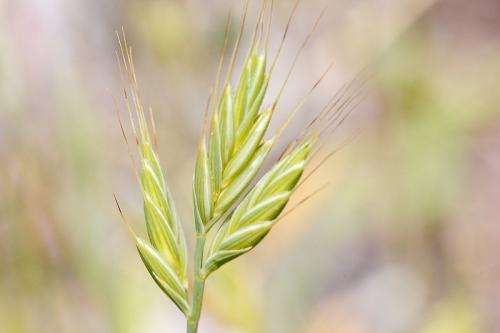Unannotated genes identified through sequencing multiple lines of brachypodium distachyon

Researchers used deep sequencing to look at whole-genome sequence variation in seven lines of the model grass Brachypodium distachyon and found previously unannotated genes. They also looked at genome-wide gene expression under drought-stress conditions.
Hundreds of genes not present in the reference genome and many unannotated genes were identified through this process, leading to the development of a public database for visualizing and investigating sequence variants in these lines.
Changes in the global climate, and closer to home, the ongoing drought in California, emphasize the importance of developing crops for fuel and food security that can tolerate low-water conditions. The grass Brachypodium distachyon, Brachy for short, is a model for candidate biomass feedstock crops, particularly those that can be grown on marginal lands. To assist in studying candidate biomass crops, a reference Brachy genome was sequenced and published by the U.S. Department of Energy Joint Genome Institute (DOE JGI), a DOE Office of Science user facility, in collaboration with U.S. Department of Agriculture researchers through the Community Science Program.
A single plant reference genome, however, cannot reflect all of the potential gene variants in a species, and Brachy is found in many climate zones, which would suggest that there are several adaptations for each habitat. In a study reported in the August issue of The Plant Journal, a team including DOE JGI researchers conducted deep sequencing ("the equivalent of 900-fold sequence depth of the 272 Megabase B. distachyon genome," according to the researchers) on several Brachy lines.
To understand the roles of the genome-wide sequence variants they found, the team conducted a series of experiments in which they simulated drought-stress conditions on several Brachy plants. They then looked at the transcripts from the plants to identify genes involved in the plant's response to drought stress. The team found nearly 900 genes "that responded significantly" to water stress.
"Our validated datasets demonstrate the existence of extensive natural variation in B. distachyon," the team concluded, "[and] demonstrates the utility of our resequencing data as a foundation for studies of natural diversity in B. distachyon."
More information: Gordon SP et al. "Genome diversity in Brachypodium distachyon: deep sequencing of highly diverse inbred lines." Plant J. 2014 Aug;79(3):361-74. DOI: 10.1111/tpj.12569.
Journal information: The Plant Journal
Provided by DOE/Joint Genome Institute





















